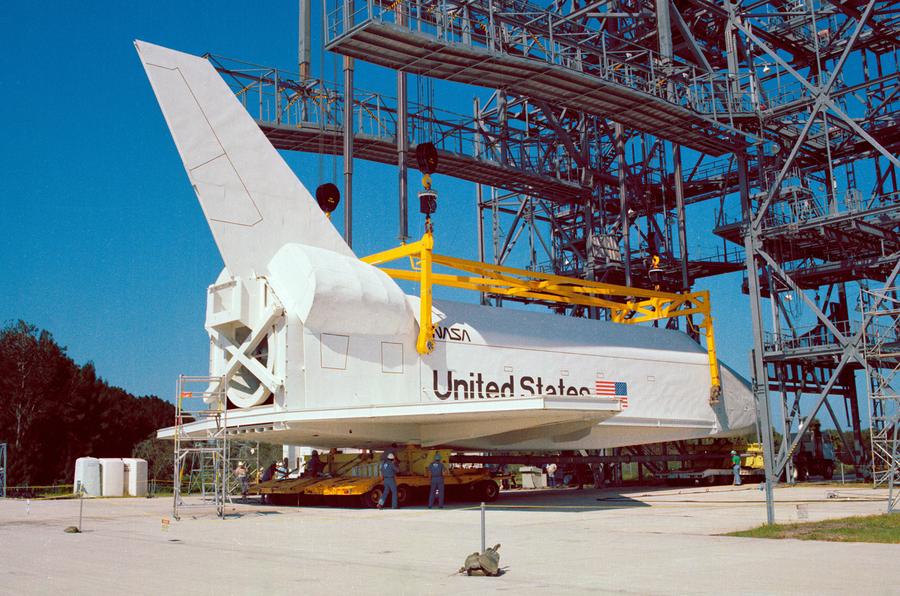
The Space Shuttle’s main engines were throttled up to 104 percent of their rated thrust level, the Challenger executed a programmed roll maneuver, and the engines were throttled back to 94 percent. Other vapors in this area were determined to be melting frost from the bottom of the External Tank or steam from the rocket exhaust in the pad’s sound suppression water trays. Launch sequence films from previous missions were examined in detail to determine if there were any prior indications of smoke of the color and composition that appeared during the first few seconds of the 51-L mission, NASA noted in its official report on the disaster. The black color and dense composition of the smoke puffs suggested to NASA that the grease, joint insulation and rubber O-rings in the joint seal were being burned and eroded by the hot propellant gases. At 3.375 seconds the last smoke was visible below the Solid Rocket Boosters and became indiscernible as it mixed with rocket plumes and surrounding atmosphere. The last smoke was seen above the field joint at 2.733 seconds. Computer graphics applied to NASA photos from a variety of cameras in this sequence again placed the smoke puffs' origin in the 270-to 310-degree sector of the original smoke spurt.” As the Shuttle increased its upward velocity, it flew past the emerging and expanding smoke puffs. The multiple smoke puffs in this sequence occurred at about four times per second, approximating the frequency of the structural load dynamics and resultant joint flexing. While each smoke puff was being left behind by the upward flight of the Shuttle, the next fresh puff could be seen near the level of the joint. 836 and 2.500 seconds, said NASA: “The smoke appeared to puff upwards from the joint. Eight more distinctive puffs of increasingly blacker smoke were recorded between. This area of the solid booster faces the External Tank. Computer graphic analysis of film from other cameras indicated the initial smoke came from the aft field joint of the right Solid Rocket Booster. NASA continued that the two pad 39B cameras that would have recorded the precise location of the puff were inoperative. 678 seconds into the flight, said NASA, “photographic data show a strong puff of gray smoke was spurting from the vicinity of the aft field joint on the right Solid Rocket Booster.” (Nick Redfern) The FBI did an excellent investigation of the tragic and terrible incident. The maximum structural loads on the aft field joints of the Solid Rocket Boosters occur during the ‘twang,’ exceeding even those of the maximum dynamic pressure period experienced later in flight.” Just after liftoff, at. These loads are released during the first few seconds of flight in a structural vibration mode at a frequency of about 3 cycles per second. During this prerelease ‘twang’ motion, structural loads are stored in the assembled structure. When the Shuttle assembly springs back to the vertical, the solid rocket boosters’ restraining bolts are explosively released. Thrust of the main engines bends the Shuttle assembly forward from the bolts anchoring it to the pad.

Who invented the nasa space shuttle full#
“At 6.6 seconds before launch, the Challenger’s liquid fueled main engines were ignited in sequence and run up to full thrust while the entire Shuttle structure was bolted to the launch pad. NASA responded with a detailed study of the evidence. The two Solid Rocket Boosters flew out of the fireball and were destroyed by the Air Force range safety officer 110 seconds after launch.” But, how did such a thing happen? Inquiring minds – including the government, the media, and the general public – wanted answers. The result, as NASA noted was that this, “…exposed the Orbiter to severe aerodynamic loads that caused complete structural breakup. Just seventy-three seconds into the flight a deadly explosion of oxygen and hydrogen propellants blew up the shuttle’s external tank. The flight of Challenger – dubbed Mission 51-L – commenced at 11.38 a.m. Before we get to the conspiracy theories, however, let’s first take a look at what we know for sure, based upon NASA’s careful study of all the evidence available. And, although the official verdict was that the Challenger disaster occurred as a result of wholly down to earth reasons, a wealth of conspiracy theories surfaced in the wake of the affair, all of which were carefully investigated by none other than the FBI. Smith, payload-specialists Gregory Jarvis and Christa McAuliffe, mission-specialists Ellison Onizuka, Judith Resnik and Ronald McNair, and the commander of the flight, Dick Scobee.

Worse still, all of the crew lost their lives in the fiery explosion that took out the shuttle. Not long before midday on January 28, 1986, NASA suffered what was, without doubt, its worst catastrophe ever: the destruction of the Challenger Space Shuttle.


 0 kommentar(er)
0 kommentar(er)
